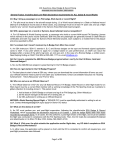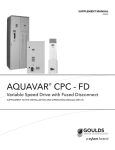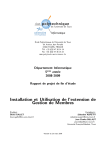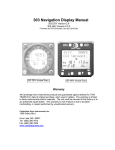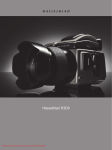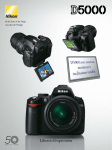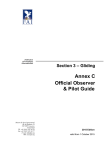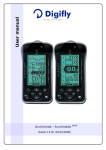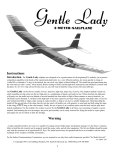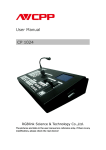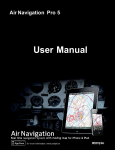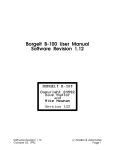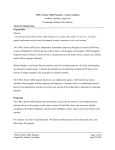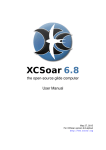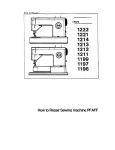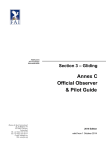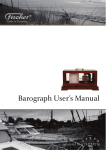Download 101 Questions About Badge & Record Flying
Transcript
101 Questions About Badge & Record Flying Changes effective 1 October 2009 shown by shading General Topics: Q1. May I bring a passenger on an FAI badge, SSA Award or record flight? A. The pilot must be alone in the aircraft except during: (1) a World record attempt or a State or National record attempt in a Multiplace record class; in these cases, any passenger must be at least 14 years old; and (2) a flight made for “Lennie” Awards granted in the Symons Wave Memorial Award program. Q2. Will a passenger on a record or Symons Award attempt receive recognition? A. For US National & World Soaring records, a passenger who holds a current NAA-issued FAI Sporting License will be named on the pilot’s record certificate. Both the pilot and passenger are generally named on State Record certificates and both may apply for Symons Wave Memorial awards, each subject to a modest fee for the plaque and pin(s) awarded by SSA. Q3. I've soloed, but I haven't received my A Badge from SSA. How come? A. An SSA Instructor (“SSA I”) awards A, B, C and Bronze badges on the spot and forwards signed application cards to SSA. If any pilot wishes to apply for a badge based on past performance, an SSAI can issue the badge(s) after a review of the pilot’s log book, an oral quiz and, in the case of a Bronze Badge, a written exam. Need helping finding an SSAI? Call SSA at 505-392-1177 or e-mail [email protected]. Q4. Do I have to complete the ABC/Bronze Badge program before I can fly for the FAI Silver, Gold and Diamond Badges? A. No, but the ABC/Bronze program is great training for the FAI Badge program. Q5. Can I claim more than one accomplishment for the same flight? (i.e. Bronze Badge and Silver Distance, Silver and Gold Altitude, Gold Distance and Diamond Goal) A. In most cases, yes. The lone exception: a pilot can earn ONE Diplome for any one flight, awarded at the level immediately less than the distance flown. (A 1,500 km flight earns the pilot a 1K5 Diplome, not 750 km, 1,000 km and 1250 km Diplomes as well) Q6. What is it going to cost for my awards to be processed by SSA? A. SSA charges nothing for processing members’ FAI badge and record claims. Otherwise - $20 Non-member badge and record processing - $40 Symons Wave Memorial Awards (for wave flights above 25,000’ MSL) - Please inquire for current National Aeronautic Association fees for processing - US National and World Records - FAI recognized US and International badge numbers on completion of (1) a US Diamond Badge or (2) a Diplome flight of 1000 km or longer Q7. How are possible violations of Federal Aviation Regulations (“FARs”) dealt with? A. SSA expects each pilot to comply with all applicable FARs, and the FAI Sporting Code contains specific prohibitions against airspace violations and unauthorized night flight. When flight evaluation suggests the latter may be an issue, the badge or record claim is placed on hold, both the pilot and OO are advised of that status and SSA requests a written explanation of the means used to comply with pertinent FARs. Q8. What is the time limit to send in the application for my badge flight? A. The application and flight documentation must be postmarked within six months after the date of the flight. An extension is granted only if these materials include errors or omissions; in these cases, the pilot is advised of a date certain by which required information must be received. Q9. Who can act as an Official Observer? A. The Official Observer (“OO”) for any US National Record, FAI Badge, State Record or other flight made for an SSA Award must be a current SSA member with a working knowledge of the FAI Sporting Code as it pertains to gliders (Section 3) including Annex C. This person must: 1. hold at least an SSA B Badge or at least one leg of an FAI Badge (eg: Silver Altitude);or 2. be the airport manager at the take off or landing site, or 3. be SSA authorized in writing as an Official Observer BEFORE a World Soaring Record flight, a “SENIOR OO” must be specifically authorized in writing to act as such. Contact [email protected] to apply for Senior OO status . Q10. What are the duties of an OO? A. An OO must perform pre- and post-flight supervision including checks of data recording instruments in the glider; for a flight documented by Flight Recorder, the OO must also perform or supervise data file download. In all cases, the OO performs a post flight review of flight data, and must be satisfied the flight was conducted in compliance with the FAI Sporting Code. Then, the OO – - completes and signs the Application Form(s), - provides a written explanation for any anomalies in flight data - provides all flight documentation and items listed on page 2 of the Official Observer’s Checklist (also listed on page 2 of the SSA Master Application Form); and - submits the above by mail to SSA at PO Box 2100, Hobbs, NM, 88241-2100. Q11. What if the pilot submits the application and/or flight data? A. In any instance where the pilot submits items by mail or e-mail, the application will be placed on hold until the OO is contacted to confirm all required pre- and post-flight procedures were followed. Q12. How can I find more about badge and record requirements? A. Within this FAQ, use the “search” function and keywords of your choice to find more items specific to the claim and documentation type(s) of interest. Online, check SSA.org and links at “Soaring Achievement,” and “Badge Info.” If questions remain, e-mail these to [email protected] Documentation issues for ALL CLAIMS Q13. What’s the basis for determining in-flight altitudes on badge & record flights? A. By FAI Sporting Code definition, release, low, high, Start and Finish Altitudes as well as gain and loss of height are calculated from pressure data provided by a recording barometer, known as a barograph. Q14. How does a barograph record altitude and time? A. Mechanical barographs are powered by a wind-up click mechanism, providing a continuous record of pressure changes on a paper or foil recording medium that requires graphic analysis. Electronic models – including the pressure altitude recording functions incorporated into an IGC Approved Flight Recorder (“FR”) - are battery powered, recording digital pressure data and converting this to an altitude equivalent in meters requiring numeric analysis. In all cases, the barograph equates pressure changes with changes in altitude In order to estimate absolute altitude from any barograph, raw data is first corrected for instrument error noted during calibration by an approved laboratory; the resulting calibrated altitude is then corrected for non-standard pressure recorded near the time and place where the raw pressure altitude was recorded. Q 15. What is a barogram? A. ”Barogram” is the term for the recording made by a mechanical barograph. Most of these use a rotating drum as the platform for paper or foil, used as a recording medium; some rely on wax-coated paper drawn from one spool to another. When turned on, the vertical position of a stylus in contact with the recording medium varies with changes in barometric pressure, creating a “trace” of pressure changes. In the case of electronic barographs, a digital listing of raw pressure altitudes may be accompanied by a graphic depiction that resembles a mechanical barograph’s “trace.” Q16. Can any badge, record or award flight be documented by mechanical barograph? A. No. World Records require documentation by a Flight Recorder (“FR”) IGC-approved at the “All Flights” level and US National records require documentation by an FR approved at any IGC level. Q17. How does an electronic barograph differ from an IGC Approved FR? A. Where an electronic barograph typically records only time and pressure altitude data, an IGC-approved FR also tracks position, satellite derived altitude and other data at a user-selected sampling rate. Q18. I have a GPS position recorder that produces an “IGC” file – is it OK for badges? A. Not necessarily. Check at http://www.fai.org/gliding/gnss to see if your instrument is IGC approved at the proper level. If not, you may use the instrument for navigation, but a badge flight made before 1 October 2009 must be documented by FR or barograph and, in the case of cross country flights, film. Film will no longer be accepted for cross country flights made on or after 1 October 2009. As of that date, GPS position recorders other than IGC-approved Flight Recorders may be used for Silver or Gold badge legs and State Records IF... ... the device is SSA approved before flight ... a mechanical or electronic barograph is also carried in flight to record pressure altitude Q19. Is a barograph or other data recording device required for all badge and record flights? A. Yes, with the exception of the Silver Duration. In this one instance, an OO may observe take off, release and maintain "continuous surveillance" throughout the flight, culminating in the landing. Q20. What is a pre-flight timing mark and why is it important? A. A pre-flight timing mark provides a way to reconcile recorded data and events witnessed by a ground-based OO. It’s vital in instances where, for example, the release from aero tow is indistinguishable on the barogram or in FR data. An accurate timepiece with digital display of seconds establishes “official” time, and an OO uses this or a synchronized timepiece to note the exact times of take off, release and - less often - Start and/or Finish Line crossing documented by mechanical barograph and ground observation. When using a mechanical barograph, the timing mark is made on the barogram AFTER the barograph is turned on, and BEFORE it is sealed and installed in the glider. An assistant writes down the exact time as the OO gently flicks the recording stylus upward by about 1/4 to 1/2 inch. For an electronic barograph or FR, an OO simply synchronizes his or her watch to the time displayed before flight by the instrument. In all cases, the OO notes the official times of take off, release and any Start /Finish line crossings observed from the ground. See Q48 for details on how this information enters into post-flight analysis. Q21. How is a barograph, FR or other recording device "sealed"? A. Most mechanical barographs are sealed closed using a wire with an attached lead bead; the wire is threaded through the handle, a special tab on the case and through the lead bead, which is then crimped down on the wire. For any other equipment, the OO may apply and initial a self-adhesive sticker, if it’s the type which cannot be removed without being destroyed. (These are available at well stocked office supply stores.) See also the IGC Approval Document for information on when and where sealing is required for different FR models. Q22. What is the purpose of sealing the barograph, FR or other recording device? A. Sealing ensures there is no access to recorded data between (1) the time an Official Observer performs a preflight check of the instrument’s serial number and installation in the glider; and (2) the OO’s first post-flight opportunity to retrieve the data the instrument recorded. Q23. Where is the barograph or FR installed during the flight? A. A barograph must be installed in a location inaccessible to both the pilot and any passenger carried on a Symons Memorial or multiplace record flight. In the case of FRs, the means to re-set the sampling interval or create a “Pilot Event Marker” should be within the pilot’s reach, but he FR itself and connection ports must be inaccessible to the pilot and/or sealed, as directed in the IGC Approval document. Q24. When I land, shall I immediately turn off the barograph or FR? A. It’s a better idea is to let the instrument run for at least 15 minutes after landing. If a barograph or FR is turned off too early, the landing and rollout may not establish a viable post-flight baseline for altitude analysis purposes. That said, a barograph or FR should always be turned off prior to a retrieve by trailer. Q25. Are there specific procedures for different models of electronic barographs or FRs? A. Yes. Before using any electronic barograph or IGC Approved FR, both the pilot and OO should be thoroughly familiar with its users’ manual and, in the case of FRs, the IGC Approval Document available online at http://www.fai.org/gliding/gnss. Q26. What is the "altitude range” of the barograph or FR? A. The altitude “range” is the maximum height for reliable operation, as proven during calibration. Some older mechanical barographs have an upper range of only 12,000’ or 15,000’ MSL; most newer barographs and FRs have an upper range of at least 30,000’ MSL. Q27. What is "calibration" and where do I do get this done? A. No mechanical or electronic barograph is 100% accurate throughout its range, so all of them must be tested in a pressure chamber periodically to make note of inherent instrument error. See SSA.org and use “Soaring Achievement” and “Badge Info” links to access current information on SSA calibration labs. Q28. I fly at an airport where the pressure altitude can be below sea level and my barograph [or FR] isn’t calibrated that low. Is this a problem? A. It can be, because pre- or post-flight “baselines” recorded outside the calibrated range of the instrument adversely affect the accuracy of the calculations done to determine in-flight altitudes. To be on the safe side, any barograph used at a soaring site where the elevation is less than 400’ MSL should be calibrated at a lab capable of inducing a True Pressure altitude of at least 100’ below sea level. Q29. Does the barograph or FR have to be in calibration for all badge, record and award claims? A. Yes, the barograph or FR must be in current calibration for all badge, record and award claims. Q30. How often does a barograph or FR have to be calibrated? A. In most instances, a mechanical barograph (e.g., Winter, Replogle, etc.) must be calibrated within the 12 months prior to a badge of record flight OR within one month afterward. An electronic barograph (e.g., EW or any IGC Approved FR) must be calibrated within 24 months prior to the badge or record flight OR within two months afterward. For Absolute Altitude and Gain of Height records, available only in Open Classes in General and Feminine Categories, the barograph or FR must be calibrated both before and after the flight, within the time periods stated above. Q31. How do I know the barograph or FR has been calibrated? A. The calibration lab must provide a calibration certificate including the type, serial number and altitude range of the instrument, the date of calibration, the calibration trace, graph or table, and the date, name and signature of calibration laboratory official. For a mechanical barograph, the calibration lab may provide only a calibration trace, so the barograph owner will have to construct the graph described in SC 3, Annex C, Appendix 8, item 3.3. Q32. How is calibration data used? A. Calibration data shows instrument indicated altitude at lab-induced pressure altitudes, enabling recorded data to be corrected for both non-standard pressure and instrument error. For a complete how-to for both mechanical barographs and IGC approved FRs, see the SSA Guide to Badge & Record Procedures. Q33. Should calibration materials be submitted with each badge application? A. Claims documented by electronic barograph or IGC approved FR should always be accompanied by a copy of current calibration figures. Claims documented by mechanical barograph require submission of the ORIGINAL current calibration and the ORIGINAL calibration graph if, after making appropriate corrections for instrument error and non-standard pressure, the OO finds the flight involves an altitude gain or Loss of Height within 300 feet of an operative minimum or maximum. Q34. What is “Loss of Height”? A. In general, Loss of Height (“LoH”) is the glider’s altitude at the beginning of a soaring performance less the altitude or surface elevation at the end of that performance. For distance claims, Sporting Code 1.4.7 provides for LoH to be measured from release altitude to Finish Point elevation, and in most instances, this is the only option for barograph documented claims. For flights made before 1 October 2009, there are as many as 20 other alternatives for an FR-documented claim, each based on ANY applicable Start Altitude minus ANY applicable Finish Altitude: Start Altitude Release *Start Line crossing *Start OZ exit Lowest in Start OZ Finish Altitude *Finish Line crossing *Finish OZ entry Highest in Finish OZ Motorglider MoP Start Landing site elevation *Interpolated at the Line or OZ boundary There are three changes for flights made on or after 1 October 2009... ... For FR documented flights, release altitude may be used as Start Altitude ONLY if release is claimed as the Start for duration and/or distance measuring purposes ... if OZ exit/entry or Start/Finish Line crossing altitudes cannot be determined from the barographic data, required for claims also documented by GPS Position Recorder, Loss of Height may be based on release altitude less Finish Point elevation ... A “Finish Fix” selected post-flight is an option for both distance measuring and Loss of Height, for both Straight Distance and Distance Using Up to 3 Turn Points tasks LOH calculations may differ for concurrent claims. A pilot who flies 5.3 hours from release to landing, for example, may use Release altitude less landing site elevation to determine LoH for the duration claim, while the LoH for a concurrent distance claim may be based on another alternative outlined above. Q35. What are the Loss of Height penalties for various badge and record claims? A. LoH penalties are as follows: - Duration and speed claims are invalid if the LoH exceeds 1,000 meters (3280.8 feet) - For any distance claim course of 100 km (62.1371 sm) or less, the maximum LoH is 1% of the course distance; a greater LoH invalidates the claim - For a distance claim using a course of more than 100 km, 10,000 feet (1.894 sm) is subtracted from the course distance for every 100 feet of LoH in excess of 1,000 meters (3280.8 feet) GENERAL PROCEDURES: Mechanical Barographs Q36. What is "smoking" the barogram? A. When a mechanical barograph’s recording medium is foil, it’s first mounted on the drum and then rotated over burning camphor, ideally resulting in light but even coating of "smoke." In flight, the barograph stylus records pressure changes by scratching through this coating. Q37. When and how tightly should I wind the barograph? A. Check the barograph before each flight, gently moving the winding lever to feel for resistance from the clock mechanism. If there is little or none, the procedure is similar to winding a clock: go slowly and stop when you feel noticeable resistance – do NOT try to get “one last click.” Q38. What markings have to be written on the barogram PRIOR to the flight? A. PRIOR to the flight, the FAI Sporting Code REQUIRES the OO to make a pre-flight ID mark on the barogram. This is a distinctive symbol, not writing that can be confused with required information which may be added after the flight. To minimize the chance that a claim fails for lack of a clear release “notch,” SSA also suggests the OO use a reliable timepiece with second hand or digital display of seconds to make a pre-flight timing mark on the barogram (See Q20 and Q48 for details) Q39. Can I use barograph paper or foil other than that supplied by the barograph manufacturer? A. Bad idea. At best, trying to “economize” by using different materials can, over time, affect the instrument’s ability to function properly. At worst, a one-time substitution may cause barograph failure. Q40. Do I need to put a pre-flight baseline on the barogram? A. No. It’s better practice to (1) turn on the barograph and install it in the glider no less than 15 minutes and no more than 30 minutes before anticipated take off; and (2) after landing, allow the barograph to run for 15 minutes or so before turning it off. Q41.There are a number of settings for my barograph drum rotation rate. What’s the best? A. In general, a 4 hour - or mid-range - rotation setting is preferred. Mechanical barographs seem to be more susceptible to clock mechanism failure using their fastest rotation rates; at the other end of the spectrum, a slow rotation rate can lead to the needle hanging up on a minor imperfection on the surface of the recording medium. Q42. What’s the best way to mount foil or paper on a drum barograph? A. Standing at a flat, level work surface at approximate table height, place the barograph drum on it, so the holddown bar is opposite you and laid open. (If the drum has no bar to hold the recording medium, apply a vertical strip of double-sided tape on the drum, and place this facing away from you.) Use a thumb to place the approximate center of the blank paper or foil on the drum opposite the hold-down bar or tape strip, and use cupped hands to smooth it gently around the drum. Use your fingers to make sure the left edge of the foil or paper is UNDER the right edge, as you look down from above. For barographs that use double-stick tape to secure barograph paper, press the edges into position, with the left (underneath) edge covering about half the width of the tape. For barographs using a hold-down bar to secure paper or foil, use one hand to hold the edges in place and use the other hand to move the hold-down bar into place and secure it. It’s not only OK but preferred for the right edge of the foil or paper to extend slightly out from under the hold-down bar, as long as no imperfection along the exposed edge can disrupt the needle’s travel across it. Check all the way around the drum for trouble spots and start over again if you find (1) any place where the recording or fixed needle may “hang up”; or (2) any place where the foil or paper is not held flat against the drum; or (3) the upper and lower edges of the foil or paper don’t match up, indicating it’s been installed crooked. Q43. What is the best position for a mechanical barograph when it’s installed in the glider? A. A mechanical barograph should be secured in the glider in an upright position so the stylus can record properly. Holding the barograph in place using bungees wrapped too tightly around the case may squeeze the barograph and hinder the rotation of the drum. Q44. Is it OK to tape a mechanical barograph’s on/off switch in the ON position? A. It is not only OK, it’s a recommended procedure to make sure it has been turned on (!) and not accidentally turned off in flight. Q45. I'd like to see what the trace looks like during the flight. Can I put it near me in the cockpit? A. The barograph must be inaccessible to the pilot and any passenger in flight, so it’s not likely you’ll be able to see what it’s recording - and in most gliders, you probably won’t hear it ticking in flight, either. Q46. What are post-flight procedures for mechanical barographs? A. The pilot may remove the barograph from the glider, but it must be unsealed by an OO who checks for the pre-flight ID mark and determines whether lack of a clear release “notch” means the timed barograph procedure is required. If the release notch is clear... ... a paper barogram may be removed from the drum ... a foil barogram must be inspected to make sure no critical point such as the release, low, or high point was recorded on the hold-down bar. If not, the foil barogram is sprayed with a light coat of fixative before removal from the barograph drum. Q47. What if one of those critical points is right on the hold-down bar of a smoked foil barogram? A. The OO places the drum atop a flat surface. Without obliterating the trace or pre-flight ID mark, the OO holds the top edge of the foil against the drum and releases the hold-down bar, touching it only at or near the top. The OO then maneuvers the foil, smoked-side up, onto a flat surface for a light, even coating of spray fixative. The OO then “lifts” the trace from the hold down bar by carefully applying a piece of clear tape over its entire length. The tape is placed sticky-side down on a piece of white paper – and this, in combination with the foil, enables analysis of the complete “trace.” (This is easier than it sounds...) Q48. How is a drum barograph’s timing mark used in post-flight analysis? A. After the flight, the barograph is turned off and the barogram is left ON THE DRUM. The clock mechanism is re-wound and the drum is rotated manually to the point where, when the barograph is turned on, the recording stylus will be on the timing mark. (The barometric pressure probably won’t the same as when the timing mark was made, so the recording stylus will actually contact the barogram on the arc established by the timing mark, not on any pre-flight baseline.) The OO collects the timing notes of actual take off, release and any other in-flight events, in each case finding the elapsed time after the timing mark was made. Let’s say take off was at 12:14:10, release at 12:17:35 and Start Line crossing at 13:20. Assuming the post-flight timing will begin at 7:00:00 pm, the OO notes the times that will correlate to the proper elapsed time for each event. (eg: 7:14:10 for take off, 7:17:35 for release and 8:20 for the Start Line) When 7:00:00 pm is shown on the same timepiece used to note the actual times, or a timepiece synchronized to it, the OO turns the barograph on. At each of the elapsed times correlated to an in-flight event, the OO gently “flicks” the recording needle of the running barograph, deflecting it through the barograph trace. After all in-flight timing marks have been transferred to the barogram, the barograph is turned off and normal post flight procedures are used to preserve the trace. In post flight analysis, the OO evaluates release and other altitudes where the appropriate timing marks intersect the trace. Note that Start and Finish Line crossings based on ground observation are invalid if higher than 1000 meters (3280.8 feet) AGL, but no such restriction applies to FR-recorded Start & Finish Line altitudes. A word of caution: This procedure is not easy to master, but it can “save” a claim otherwise invalid for lack of a discernable release “notch.” The OO performing this should have one or more practice runs before attempting the timed barograph procedure for a badge or State record claim. Q49. HELP! (Pick one: My OO smudged my trace and/or obliterated the pre-flight ID mark / the barograph quit completely / the barograph drum stopped rotating / for unknown reasons, the barograph shows only part of the flight) Can this trace be accepted? A. If any part of the barogram was smudged or a barograph malfunctioned, the question is whether critical altitudes can be determined and how well the remaining trace can be interpreted. The trace, an award application form and the OO’s written explanation for any missing data should be submitted, and both the pilot and OO will be advised on whether the trace is acceptable. Q50. I used a Replogle barograph but the factory paper was mounted upside down. Now what? A. No problem, if the paper was otherwise mounted correctly. Even when the paper is mounted right-side-up, the numbered reference lines on it are for estimation purposes only. Q51. When should calibration be submitted for a mechanical barograph and are copies OK? A. SSA requests mechanical barograph calibration materials when the altitude gain or LoH is within 300 feet of an operative minimum or maximum. Most photocopy machines yield a true 100% scale copy only in the very center of the image, and the width of a scribed line can represent 100 feet or more (!), so the ORIGINAL barograph calibration barogram and a graph constructed from it are needed. Q52. What information must be written on a barogram? A. An OO’s pre-flight ID symbol must be written on the barogram before flight. The following items are also required for claim submission, but may be written on the barogram after the flight: - For [State] altitude records, the pressure at ground level (QFE) at time of takeoff, - Date of flight, - Name of pilot, - Type, serial number and altitude range of barograph, - Type and registration of glider, - Altitude of release - Date and signature of OO after landing. If any of the above is missing from the barogram, the OO will be sent a copy of the barogram and asked to clarify; the application will be processed when the annotated copy is returned Q53. Do I have to send in the barogram from the flight or can I send in a copy of it? A. The original barogram must be sent in with your completed application. If you want copies of the barogram or other flight documents, have them made before you send it to the SSA. Use a cardboard or bubble-padded envelope for mailing, and place the barogram between pieces of cardboard. Do NOT tape the barogram to the cardboard! THIS SPACE INTENTIONALLY LEFY BLANK GENERAL PROCEDURES: Cameras used for cross country flights made before 1 October 2009 Q54. What kind of camera can be used? A. The Sporting Code requires a cockpit-mounted camera and a “continuous strip” of film. Any camera which can be opened to load film MUST be sealed (See Q21) Q55. What’s the “canopy mark” required for a film-documented flight? A. The canopy mark is an OO’s distinctive grease pencil mark applied to the outside of canopy, so it appears in each photo taken, confirming the photos were taken on a certain day from inside a certain glider. Water soluble pen is unacceptable for the canopy mark - it won’t show up on film. Q56. What photos are required? A. SSA recommends a full-frame shot of the declaration, taken before mounting the camera. FAI then requires the camera be mounted in the glider for a photo of the declaration, taken through the required canopy mark; for best results, the OO should hold the declaration 4 to 6 feet in front of the camera. Other photos, in order, must include: - for a Start other than release or Start Line crossing, a photo taken from within the Start OZ Sector. - photographs of declared turn points (if any), each taken from within the Turn Point OZ Sector - for a Finish other than landing or Finish Line Crossing, a photo taken from within the Finish OZ Sector - after landing, the camera must remain sealed but may be removed from the glider in order to take required post-flight photos of either (1) the landing site, with the glider and its registration number clearly visible; or (2) the original pre-flight declaration, with landing time added. Q57. Is there any requirement to use a camera that prints the date and time on the film? A. No such requirement exists in the current Sporting Code. Q58. How difficult is it to take a photo of a particular place from inside the proper quadrant? A. Many pilots draw the OZ sector on a map carried in flight – others draw just an arrow, indicating the heading calculated to yield the perfect waypoint photo. You needn’t perform an aerobatic maneuver to put the wingtip exactly on the waypoint... the photo need only show the glider was in the OZ when the photo was taken. Q59. What if the continuous strip of film is cut at one of those 1-hour processing places? A. If the film ends up in pieces, the OO must explain who cut the film and why. One related note about film developing: most customers want flaws erased from photos, so prints may show your precious grease pencil mark has been “processed” right out of existence. If the mark was in the frame, the OO will find it on the negatives as a familiar but fuzzy shape. This is perfectly normal. Q60. How are OZ Sectors evaluated using film? A. Ideally, the OO reviewing the film is a pilot familiar with the waypoints, so a photo taken from the center of the OZ and showing the waypoint or nearby landmarks is an easy call. When the film doesn’t clearly show the waypoint and/or the glider appears to be quite near the OZ boundary, online topographic maps and aerial photos should be consulted. Whether or not the film was cut, the OO must confirm the order in which declared waypoints were used, and he or she will need to bear in mind that multi-use 35-mm cameras place the first photo at negative #1, but disposable cameras expose frames in reverse order. Q61. For a photo documented flight, are negatives, prints or both submitted with the application? A. The original negatives, preferably uncut, MUST be submitted and a full set of prints is appreciated. If the film strip remains intact after developing, place it in the film canister or wrap it around a cardboard form so the film isn’t creased in transit. The film, barogram, the OO’s explanation for any anomalies in flight documentation and a completed application should be mailed to SSA in a bubble-padded envelope. GENERAL PROCEDURES: ELECTRONIC DATA RECORDING Q62. Do I need an Official Observer for a flight using an IGC approved FR? A. YES - the OO’s duties are spelled out in Sporting Code and at Q10. Q63. I posted a great cross country flight on OLC - doesn’t that earn me an FAI badge? A. OLC is a wonderful forum for pilots to see where they rank in local, national and international standings. Still, there’s a difference between having a great flight and earning an FAI badge based on Sporting Code rules. If you wish to claim an FAI badge, please use this FAQ as a guide to both the rules and the application process. Q64. What is the best sampling rate to use during my flight? A. SSA recommends a split setting, if possible, so the sampling rate is 2 seconds near electronically declared waypoints and 4 seconds or more elsewhere. This avoids instances where an early model FR’s continuous 2second sampling rate may deplete the battery or overwrite data files prematurely. Q65. Shall I use evaluation software or the FR manufacturer’s “fast download” for downloading? A. Neither! Such programs can alter the data file, rendering it unusable for badge & record purposes. The data file should be downloaded following IGC Approval document procedures and using the appropriate IGC Approved program, available online at http://www.fai.org/gliding/gnss/freeware.asp Q66. If an Official Observer is not present at my landing, may I turn off the recorder? A. Yes. After you clear the landing area, wait a few minutes to make sure a stationary position is recorded - then turn the FR off. As usual, data download must be performed or supervised by an OO and any seals must remain intact until removed by an OO – preferably the same one who applied the seal(s). Q67. How does evaluation software determine release time, and how can I check this? A. Evaluation software often tags release at the first altitude loss marking the end of a fairly consistent rate of climb, in much the same way an OO looks for a release “notch” on a barograph trace. To verify release, check the ground track beginning at take off, looking for a distinctive turn off tow. If release is still unclear, the Sporting Code provides for release location certified by the tow pilot; if not inconsistent with FRrecorded data, this can be used to determine when and where release took place. Q68. How can I determine a motorglider’s FR-recorded “Means of Propulsion” stop point? A. Most FRs IGC-approved for use with motorgliders record Engine Noise Level (“ENL”) data by microphone. Assuming it’s properly placed, use evaluation software ENL graphics to check when ENL was above the threshold for engine use. Consider altitude data, the phase of flight and the duration of any short-duration indications of high ENL and refer to the IGC Approval Document to determine whether these may reflect such things as slipping, flight with the gear down, gear doors flapping, or an open air vent. Once the probable time when the MoP was shut down is decided, correlate this to FR position and altitude data. Q69. How many copies of the original data download should be made? A. Ideally, one for the pilot and TWO for the OO - one for post-flight analysis, and the other to be stored untouched on a hard drive or memory device to which the pilot does not have access. The untouched file, copied to disk, CD, memory stick or memory card is sent to SSA and the original should be retained by the OO until badge or record processing is complete. Q70. My data file looks OK in evaluation software, so is a security check necessary? A. YES, and it should be checked by the OO ASAP after the flight and before the data file is submitted to SSA. Why? Because evaluation software doesn’t detect innocent flaws which can corrupt a data file during download. It’s only a question of time before any flight is over-written in FR memory, so if no security check is done until SSA reviews the data file submitted, the original data may be irrecoverable and the pilot’s claim will have to be denied. NOTE : Security Check procedures for GPS devices other than FRs have yet to be developed, and must be reviewed by FAI before any such device is approved for use. Q71. How’s a security check done? A. For most FRs, go to http://www.fai.org/gliding/gnss/freeware.asp, download and install both the IGC “Shell” and the proper “DLL”. These point-and-click programs indicate file security with the message, “Log file has been successfully validated.” When any other message appears, contact the FR distributor or manufacturer to determine the cause. The following procedures apply to FRs for which there is no “DLL”. 1. Download & install the proper “Vali” program at http://www.fai.org/gliding/gnss/freeware.asp 2. Create a shortcut to DOS on the computer desktop. (Refer to Windows help files and note that Windows XP and Vista refer to DOS as a program named “CMD.exe”) 3. Open DOS using the shortcut on the desktop. The cursor automatically appears after the “command prompt,” which appears something like: C:\Folder\File> 4. Type CD, leave a space, and... a. If the “Vali” program is NOT in a folder, type the letter of the proper DRIVE, followed by :\ If the “Vali” program is on the C drive, the “command prompt” now reads: C:\> b. If the “Vali” program is in a folder, type the letter of the DRIVE, followed by :\ and the folder name. If the “Vali” program is on the C drive in a folder names “CAM”, you’ll see C:\CAM> 5. Type Dir, leave a space, type the letter of the drive where the data file is located, followed by :\ and, if the data file is in a folder, type the name of the folder a. If the data file is on the D drive, type Dir D:\ b. If the data file is on the D drive in a folder named “DOCS,” type Dir D:\DOCS 6. A list of files will display. Find the file you want, noting that the first three digits of the filename are YEAR, MONTH and DAY, with the 10th of the month and the tenth month both being “A,” the 11th “B” etc. (eg: the filename for a flight on 12/15/2008 would start with the characters 8CF) 7. At the command prompt, type the name of the security checking program specific to the FR model. Leave a space and type the drive where the data file is located, followed by :\, the folder name, followed by \ and the file name EXACTLY as shown in the list of files. Note that a Cambridge 10/20/25 FR requires security checking the CAI file, and the non-standard name of the “vali” program for a Cambridge 302 FR is Valicam2 Using Cambridge FRs as an example: a. For a data file named “63icb2h1” located on the C drive in a folder named DOCS, type: Vali-cam c:\DOCS\63icb2h1.cai if the data file was recorded by a Cambridge 10, 20 or 25 OR Valicam2 c:\DOCS\63icb2h1.igc if the data file was recorded by a Cambridge 302 b. If the data file is located on a CD, not in a folder, and the CD reader is drive D, type: Vali-cam d:\63icb2h1.cai if the data file was recorded by a Cambridge 10, 20 or 25 OR Valicam2 d:\63icb2h1.igc if the data file was recorded by a Cambridge 302 The “Vali” check is done in 3 seconds or less, and the resulting message will be very clear if the file passes or fails. (eg: “Pass” or “OK,” vs “Fail”) If you’ve omitted or confused the .igc and .cai “extensions”, mistaken an O for a zero or otherwise made an error in typing the complete filename, you will receive an error message such as “[file] NOT FOUND! ” or a message indicting the file cannot be opened. Try again, starting at step 5. Q72. Help! I’m an OO who submitted an FR data file on a CD, but The Badgelady tells me it arrived with nothing on it. Now what? A. Unfortunately, the CD writing “wizard” doesn’t “know” what data actually made the leap to CD – so a wise OO always double checks! If the file isn’t there, the problem could be (1) a hard drive with limited disk space available; or (2) an interruption in the flow of data to the CD burner; or (3) an incompatible brand of CD; or (4) a CD write speed too fast for the amount of data in the IGC file. To solve the dilemma, the OO – having retained the original data file - simply submits another copy of the original data download. For more reliable CD writing, the OO should first run “Disk Clean Up” and “Disk Defragmenter” utilities (typically accessed in Windows through “Start”, “Programs” and “Accessories” links); and then - disable any screensaver which may begin during the CD writing process; and - close all other programs If problems persist and involve a particular CD brand, switch brands; if problems remain at that point, consult Windows help files, specifically the Microsoft Knowledge Base article on “How to Troubleshoot Issues that occur when you write data to a CD-R or CD-RW” and the section on “Inconsistent recording of files to the disc.” THIS SPACE INTENTIONALLY LEFT BLANK CROSS COUNTRY TASK PLANNING & DECLARATION ISSUES: ALL Documentation Types Q73. What are waypoints? A. Waypoints are locations the pilot intends to achieve in flight. When a cross country badge flight is planned, the pilot who plans to use a Start other than release/MoP shut down and/or a Finish Point other than landing/MoP Start must “declare” these waypoints electronically or in writing. For more distance measuring options, pilots may also declare a maximum of 3 Turn Points to be achieved after the Start and before the Finish. Q74. When is a pre-flight declaration required? A. A pre-flight declaration is required for ALL distance, goal and speed claims, but Waypoints need not be listed in the pre-flight declaration for... ... a Straight Distance badge flight measured from release to landing or MoP Start; or ... a “Free” record attempt See Q83 for further details on declaration format! Q75. What makes a good waypoint? A. The best waypoints for all badge and most record claims combine distinctive natural and/or man-made surface features. (eg: intersecting runways at an airport, a highway bridge crossing a river at a distinctive place, etc.) The pilot should research proposed waypoints using topographic maps or aerial photos at online sites such as Google Earth or Terra Server to determine where OZ Sectors will be and how these may be affected by an inflight change in Turn Point order. Q76. What should I avoid when selecting waypoints? A. A mountain top amid many others, the intersection of dirt roads in the desert or a sod airfield surrounded by farmland are poor choices for waypoints because they may be very difficult to locate by pilotage and dead reckoning, particularly when viewed from some distance and/ or high altitude. Clearly, this would be disastrous for a pilot who mistakes a GPS unit’s audio proximity tone for an indication of being directly over the waypoint. Q77. Where do I find the right coordinates for the waypoints I’ve chosen? A. Resources for official airport coordinates include the Airport Facilities Directory (“AFD”) published by FAA or an online resource such as Airnav, http://www.airnav.com/airports/. The Worldwide Soaring Turn Point Exchange at http://soaringweb.org/TP is a source of downloadable waypoint databases. No matter where you obtain waypoint coordinates, use an online resource such as Google Earth or Terra Server to confirm the coordinates actually represent the location you intend to use as a waypoint. Q78. How close together can turnpoints be? A. Any task may end up being credited as Distance Using Up to 3 Turnpoints, so each should be at least 10 km away from any other. See also Q82 and Q93. Q79. How do I determine the distance between turnpoints, total distance and official distance? A. To determine the distance of each task leg, use the World Distance Calculator, available online using “Soaring Achievement” and “Badge Info” links at SSA.org. When using the calculator, make sure the “earth model” is set to “WGS 84.” The sum of the “legs” is the total distance and this - less any applicable Loss of Height and Cylinder “Correction” penalties - is the “Official Distance” credited for badge and record purposes. Q80. Can a turnpoint be used more than once? A. No, but certain 3-turnpoint task configurations may mean the pilot flies through one turnpoint’s OZ both before and after achieving another turnpoint. Distance in this case is credited for the one “use” yielding the longest distance, based on the order in which any other turnpoint(s) was/were achieved. Q81. How do I prove I achieved a declared waypoint? A. Flight documentation must show the glider was in proper position at each declared waypoint: - Start and Finish Lines may be used, each 1000 meters (3280 feet) long and centered on declared waypoint coordinates. A Start Line is perpendicular to the first course leg, and a Finish Line is perpendicular to the last course leg. For flights made before 1 October 2009 and documented by film, a Start or Finish Line - if claimed - must be crossed at or below 1000 meters AGL, with crossing time verified by a ground-based OO. - At any way point, an OZ Sector is a 90-degree quadrant is located on the “non-task” side of the waypoint in question, with its apex on waypoint coordinates. Except as specified for goal and closed course flights, there is no maximum radius for this quadrant, and... ... the Start OZ Sector is bisected by the extended outbound course line ... a Turnpoint OZ Sector is centered on the extended bisector of inbound and outbound course lines ... the Finish OZ Sector is bisected the extended inbound course line ... OZ Sectors are the ONLY option for film-documented flights made before 1 October 2009 ... For Closed Course and Goal flights made on or after 1 October 2009, the radius of Start and Finish OZ Sectors is 1000 meters (1640 feet) and the glider MUST either cross the Finish Line or enter the Finish OZ Sector at or before landing. (3) An OZ Cylinder has a radius of 1/2 km (1640 feet), centered on waypoint coordinates. When this OZ is used, cylinder “corrections” decrease Official Distance by 1/2 km for each time the course line crosses a cylinder boundary. All way points claimed must be achieved by the same OZ type, except where the Start is claimed at release or by Start Line Crossing and the Finish is claimed by Finish Line Crossing or landing. For flights made on or after 1 October 2009, OZ Cylinders are valid ONLY at Turn Points, and these must be achieved using the same OZ Type, eg: Sector or Cylinder. Q82. What cross country tasks are available? A. Distance Using Up to 3 Turn Points is the most flexible badge option, and also popular for records: 1) Release/ MoP stop or a declared Start Point (if achieved) may be used as the Start Point, depending on which yields the best distance 2) No more than three turn points are declared, at least 10 km (6.21 sm) apart, and each may be used once, in any order, or not at all 3) a declared Finish Point (if achieved) or landing (not MoP start) may be used as the Finish Point, depending on which yields the best distance 3a) For flights made on or after 1 October 2009 the Finish may be claimed at a declared Finish Point (if achieved), landing, MoP Start or a Finish Fix - a recorded data point selected post-flight - depending on which yields the best distance Other tasks include different or more strict requirements: - Straight Distance is an option for badges only. (SC3 1.4.5) The pre-flight declaration need only list general information if the pilot uses release as the Start Point, with landing or motorglider engine start as the Finish Point. Distance is measured from release (or declared Start Point, if achieved) to landing or, for motorgliders, from release (or declared Start Point, if achieved) to engine start or landing, whichever occurs first. For flights made on or after 1 October 2009, an added Finish alternative is a Finish Fix selected post-flight - Straight Distance to a Goal is an option for both badges and records. (SC3 1.4.4[a]). This task differs from Straight Distance in that the pre-flight declaration must list a Finish Point/Goal, achieved as provided in SC3 4.3.3 For flights made on or after 1 October 2009, Straight Distance to a Goal is available for records only and requires a Start by Start Line crossing or by exiting a 1000-meter radius Start OZ Sector - An Out & Return or Triangle task is required for Diamond Goal and/or any speed record. (SC3 1.4.6) The pilot must use a declared Start/Finish Point, return there at the end of the soaring performance and… ... exit the Start OZ within 1000 meters of the Start Point ... use Turn Points in the sequence specified in the pre-flight declaration … achieve the Finish Point (Goal) as provided in SC3 4.3.3 … distance around a 3-turnpoint triangle is measured from turn point 1 to turn point 2 to turn point 3 and back to turn point 1; triangle distance excludes any distance flown from the Start/Finish Point to Turn Point 1 or from Turn Point 3 to the Start/Finish Point ... for records only, the individual “legs” of the triangle are subject to minimum and maximum lengths (See SC3 1.4.3.[d]iii) ... an abandoned multi-turn point task can in some cases be claimed as an Out & Return task and a 3turnpoint triangle can be claimed as a 2-turnpoint triangle. (See SC3 4.2.2[b] and Annex C, 4.4) - “Free” tasks are reserved for distance records only. Each of four task variations requires FR documentation and bears some resemblance to a “declared” task type, but in this case the pilot may choose any or all waypoints after the flight, based on data points recorded (1) after release/ MoP shut down and before the earlier of landing or MoP start. “Free” tasks include Free Distance measured straight-line between selected Start and Finish Points as well as Free Out & Return Distance, Free Triangle Distance and Free Distance Using Up to 3 Turnpoints. The table on the following page summarizes the similarities and differences between various types of tasks eligible for badge and record flights made BEFORE 1 OCTOBER 2009. (A supplement for flights made 1 October or later will be added as soon as the new SC3 is published) THIS SPACE INTENTIONALLY LEFT BLANK FOR FLIGHTS MADE BEFORE 1 OCTOBER 2009 SC3 GENERAL REQUIREMENTS Soaring Performance SC3 Cite Straight Distance Uses Items required in declaration Maximum # Course Turn Points Legs declared / Claimed claimed START ALTERNATIVES DECLARED START POINT FR Fix Release or MoP Stop REQUIRED OR OPTIONAL 1.4.5 Badge 4.2.1 (A-E) 3/0 1 NO OK OPTIONAL 1.4.4a Badge or Record 4.2.1 (A-H) 3/3 4 NO OK OPTIONAL Straight Distance to a Goal 1.4.4b Badge or Record Out & Return Distance / Speed 1.4.6a, 2.1.3b Triangle Distance / Speed (2 Turn Points) 1.4.6bii, 2.1.3b Triangle Distance / Speed (3 Turn Points) 1.4.6bii, 2.1.3b Distance Using Up to 3 Turn Points Free Distance 1.4.3a Free Distance Using Up to 3 Turn Points 1.4.3b Free Out & Return Distance 1.4.3c Required for Diamond Goal & Speed claims 4.2.1 (A-H) Distance Record Only 4.2.1 (A-E) Distance Record Only Free Triangle Distance (2 Turn Points) 1.4.3di Free Triangle Distance (3 Turn Points) 1.4.3dii Absolute Altitude 1.4.2, 3.1.2b Record only 1.2.8, 1.4.2 1.2.5, 1.4.2 Badge or Record Gain of Height Duration 4.2.1 (A-H) 4.2.1 (A-E) 3/0 1 3 / 1* 2 3 / 2* 3 3/3 3 3/0 1 3/3 4 3/1 2 3/2 3 3/3 3 FINISH ALTERNATIVES START OZ RADIUS UNLIMITED SECTOR or 500-m CYLINDER DECLARED FINISH POINT REQUIRED OR OPTIONAL OPTIONAL OPTIONAL FINISH OZ RADIUS UNLIMITED SECTOR or 500-m CYLINDER REQUIRED 1000-m SECTOR or 500-m CYLINDER Landing (1.2.10A) MoP Start OK ANYWHERE OK ANYWHERE OK ANYWHERE Only in FINISH OZ Anywhere within 1000 meters of FINISH POINT Only in FINISH OZ NO OK OPTIONAL 1000-m SECTOR or 500-m CYLINDER NO Only if declared as the START POINT REQUIRED START/FINISH POINT 1000-m SECTOR or 500-m CYLINDER REQUIRED START/FINISH POINT 1000-m SECTOR or 500-m CYLINDER Anywhere within 1000 meters of START/FINISH POINT Only in FINISH OZ at START/FINISH POINT OK OK OPTIONAL UNLIMITED SECTOR or 500-m CYLINDER OPTIONAL UNLIMITED SECTOR or 500-m CYLINDER OK ANYWHERE OK ANYWHERE OK OK START/FINISH POINT NEED NOT BE DECLARED BEFORE FLIGHT. AFTER THE START TIME CLAIMED, NO MoP USE IS PERMITTED BEFORE THE GLIDER (1) ENTERS THE FINISH OZ AT THE CLAIMED START/FINISH POINT; OR (2) LANDS WITHIN 1000 METERS OF THAT START/FINISH POINT. No declaration required, but PILOT NAME, AIRCRAFT TYPE & REGISTRATION must be recorded in FR memory or items required by SC3 6.1 must be written on barogram, as applicable to data recording used. Badge Only NOTES: World Records require (1) Flight Recorder data recording and (2) where a declaration is required, it must be in electronic form Start and/or Finish lines, 500 meters long, cetered on the declared Start and/or Finish Point(s) and oriented perpendicular to courseline, are acceptable for any type of performance *See SC3 4.2.2(b) for Out & Return and Triangle options when one or more declared Turn Points is abandoned See SC3 1.2.9, 1.2.10 and 1.2.11 for OZ Sector orientation and applicable limits & penalties for OZ Cylinder use 3-Turn Point Triangle distance for Badges and Records is measured TP#1 to TP#2 to TP#3 and back to TP#1 Records only: Minimum Leg length for Distance and Speed Triangles of 750 km or less is 28% of Official Distance; for longer courses, no leg may be less than 25% or more than 45% of Official Distance Q83. How do I make a pre-flight declaration for a badge or record distance or speed flight? A. For World records, an electronic declaration MUST be entered into the memory of an FR IGC approved at the “All Flights” level. In any other case, a pre-flight declaration may be made in writing. In ALL cases, only the last declaration made before take off is valid. Intended course type need not be declared, but ALL the following items are required, except as noted: 1. Date of flight 2. Pilot Name (and passenger name for multi-place Record claims) 3. Type and registration number of the glider 4. Type and serial number of the barograph or flight recorder 5. Way Points if/as appropriate to the planned flight *Start point *Turnpoints (No more than 3, listed in intended use order by name and/or coordinates) *Finish point 6. Date & time of the declaration (entered automatically by the FR) 7. Signature of the pilot (for written declarations only) 8. OO Signature, with date & time signed (for written declarations only) * Not required for Free record flights, see Q82. See also Q89 to declare Release as a Way Point. Written declaration forms are available at SSA.org, using the “Soaring Achievement” and “Forms” links. A written declaration is REQUIRED for flights made on or after 1 October 2009, when documented by SSAapproved GPS Position Recorder Q84. Can I make my own written declaration form? A. Yes, if it includes all the information required. For flights made before 1 October 2009 and documented by barograph and film, write BIG, using a form no less than 8.5 x 13 inches so the image can be read on film. Q85. Should I make a pre-flight declaration for a Silver Badge duration claim? A. Without a pre-flight declaration listing at least Start and Finish Points, a tow or self-launch to more than 1,000 meters [3280.8 feet] above landing site elevation would invalidate the duration claim. A pre-flight declaration could be more advantageous IF, as outlined in Q34, any one set of applicable Start & Finish times and corresponding altitudes yields both a duration of at least 5 hours and Loss of Height less than 1000 meters (3280.8 feet). Q86. Can the same place be declared as both a Start Point (and/or a Finish Point) AND as the second of three turnpoints? A. Yes, if this multipurpose way point is at least 10 km from any other declared turnpoint. Please note, however, this is an option only for a flight made as “Distance Using Up to 3 Turnpoints.” For Diamond Goal and any closed course claimed for a distance or speed record, the Turn Points must be independent of the Start/Finish Point. Q87. If my electronic declaration lists one task, may I make a written declaration for another? A. Yes, but only the LAST declaration made before take off is valid. FR users must be careful here! An electronic declaration entered into an FR last week, last month or last year [!] may be stored in memory as the “active” declaration; if so, the FR may date and time-stamp the “old” declaration when the FR is turned on, invalidating any written declaration made earlier on the date of flight. If you want to be sure a written pre-flight declaration is valid, the OO’s signature, with date and time, should be written in BEFORE take off, but only AFTER the FR is turned on, and the FR must then remain on throughout the flight. Q88. If I declare a contest task electronically and the distance qualifies for a badge and perhaps a record, I’ll get credit for all three, right? A. It’s possible, but bear in mind contest rules differ from those for badges and records. For example: - If the contest, badge and record tasks are identical and consistent with at least one of the five tasks defined in Sporting Code 1.4.4 through 1.4.6, a single electronic pre-flight declaration can be used, specifying the contest task. - Badge and record declarations may list a maximum of 3 turnpoints, so if the contest task involves 4 or more, a badge, State or US National record must use a WRITTEN pre-flight declaration. This must be signed by an OO BEFORE take off, AFTER the contest task has been electronically declared and activated. - World record declarations must be in electronic form, stored in the FR memory. Activating a concurrent but different contest task at any later time before or after take off may erase the record declaration. (Consult the FR user manual to determine whether multiple declarations can be listed in the IGC file.) - the OZ Cylinder radius for badges and records is 1/2 km. If the pilot entered the far larger contest Cylinder at any waypoint, but didn’t fly within 1/2 km of waypoint coordinates and didn’t enter the proper OZ Sector at that waypoint, it won’t be considered for badge or record purposes. Q89. My FR requires me to list a name and coordinates for Start and Finish Points. How can I declare release as a waypoint? A. FR users can create a new database entry or manually enter a waypoint named “RELEASE,” defined by coordinates of 00:00.000N and 000:00.000W. (For US National and World records, this FAQ serves as proof this “code” existed before the flight.) When this waypoint is declared, the actual coordinates of release will determined during post-flight analysis. For a “closed course,” [eg: Diamond Goal or any Out & Return or Triangle speed or distance record claim]; the “RELEASE” waypoint described above can be declared before flight as both the Start Point and a Finish Point. See Q86 before electing to declare “RELEASE” as a turnpoint. Q90. Can I declare waypoints only by name? A. The Sporting Code defines waypoints as “precisely specified” points declared by “a word description or set of coordinates,” but because distance measuring relies on coordinates, there are a couple of caveats: - When a written declaration lists any waypoint(s) by name only, the OO should submit a copy of the published source used to determine waypoint coordinates and task distance. - Electronic declarations don’t provide enough space for a precise word description, so electronically declared waypoint coordinates are generally considered authoritative. Q91. What if the declared coordinates contain a transcription or other error? A. For US National and World records, coordinates listed in an electronic pre-flight declaration are considered authoritative unless the pilot proves the waypoint name is part of a “code” established in writing or in the FR database before the flight in question. For other record or badge purposes, declaration errors must be evaluated on a case-by-case basis, with little flexibility for State records, Gold and higher badge levels. The appropriate application materials should be submitted for SSA review, accompanied by the certifying OO’s written explanation for any error(s) in the written and/or electronic declaration(s). Q92. Is my pre-flight declaration valid if it omits a required item? A. No, with one exception for FR users. Pilot name and/or aircraft registration may be generic (eg: “Club Pilot” “Club 102”) if all other information in the electronic declaration is accurate and the OO provides written confirmation of the methods used to confirm the pilot’s name and aircraft flown. An electronic declaration will NOT be accepted for US National record purposes if it does not correctly list all required items. Q93. What if I ... (pick one: don’t use the declared Start Point or Finish Point? / don’t use declared Turnpoints in declared order? / used the declared Start and Finish Points but end up with a disqualifying Loss of Height penalty)? A. If each declared turnpoint is at least 10 km from all others, Silver, Gold, Diamond or Diplome Distance and/or a record for Distance Using Up to 3 Turnpoints can be credited as follows: (1) from release to landing, via any declared turnpoints in the order used, less both Cylinder “correction” penalties, if any, and any Loss of Height penalty based on release altitude less landing site elevation; or (2) from release to declared Finish (if achieved), via any declared turnpoints in the order used, less both Cylinder “correction” penalties, if any, and any Loss of Height penalty based on release altitude less the elevation of the Finish Point or, in the case of an FR documented claim, on any more advantageous calculation outlined in Q34. (3) from declared Start (if achieved) to landing, via any declared turnpoints in the order used, less Cylinder “correction” penalties, if any, and any Loss of Height penalty based on release altitude less landing site elevation or, in the case of an FR documented claim, on any more advantageous calculation outlined in Q34 (4) from declared Start to declared Finish, if both were achieved, via any declared turnpoints in the order used, less Cylinder “correction” penalties, if any, and any Loss of Height penalty based on release altitude less Finish Point elevation or, in the case of an FR documented claim, on any more advantageous calculation outlined in Q34 (5) for flights made on or after 1 October 2009, from declared Start (if achieved) or release to a Finish Fix selected post-flight, via any declared turnpoints in the order used, less Cylinder “Correction” penalties, if any, and any Loss of Height penalty based on any applicable calculation outlined in Q 34 Q94. I couldn’t reach one of the turnpoints I declared, but I flew more than 300 km by (pick one: using another turnpoint / using the declared Start Point or the declared Finish Point as a turnpoint) Is that OK? A. The changes outlined above make the flight eligible only as a “Free” record, with some or all waypoints specified after the flight. For Badge flights, (1) intended turnpoint(s) must be declared as such prior to the flight; no additions are permitted in or after the flight; and (2) distance is never credited from release to the declared Start Point or from the declared Finish Point to landing. Q95. I declared a 1000 km 3-turnpoint triangle with a Start/Finish at my home airport. I started OK, but abandoned the third turn point and finished at home. Is the resulting 770 km flight valid? A. Yes, this flight could qualify as Silver Distance, Gold Distance, Diamond Goal, Diamond Distance, a 750-km Diplome, one or more “Free” records, and perhaps Triangle Distance and/or 750 km Triangle Speed. - abandoning the second of two (or the second and third of three) declared turnpoints can yield a viable Out & Return course, if the Goal was properly achieved; and - abandoning the third of three declared turnpoints can yield a viable 2-turnpoint Triangle course, if the Goal was properly achieved and - for records only - each triangle leg meets the requirements of SC3 1.4.3d iii The provisions of SC3 4.2.2b will be deleted as of 1 October 2009, so the flight described cannot be claimed for any of the closed course goal performances underlined above. Q96. How do distance measuring and LoH calculations differ for motorgliders? A. If the MoP is not used at all or used only for self-launching, distance is based on the waypoints achieved in soaring flight, and Loss of Height is calculated identically to any instance where the glider has no MoP. Otherwise: - if the MoP is started no later than the earlier of landing or achieving a declared Finish Point, Straight Distance is the ONLY badge eligible task. Distance would be the longer of release or the declared Start Point, if achieved, to the location of MoP start; Loss of Height would be based on the corresponding Start Altitude, less the MSL altitude at which the MoP was started. For badge flights made on or after 1 October 2009, MoP Start OR a Finish Fix selected post-flight may be claimed for either Straight Distance or a Distance Using Up to 3 Turn Points; in any case, both distance and Loss of Height would be based on the way points claimed. - a “Free” record can be credited using a Finish Point selected after the flight, as long as this Finish point was recorded no later than the earlier of MoP start time or landing. Distance in this case would be based on the selected Start Point to the selected Finish Point, via Turn Points selected post-flight by the pilot; Loss of Height would be Start Altitude less Finish Altitude. Q97. How does evaluation software determine whether I achieved a “waypoint”? A. For flights documented by FR, a “waypoint” is achieved if: - one data point was recorded exactly at waypoint coordinates; or - one or more data points were recorded in the proper OZ; or - a straight line drawn between two consecutive data points passes through the OZ. In any case, bear in mind that closed courses (eg: Diamond Goal and all Out & Return or Triangle tasks flown for distance and/or speed records) are subject to the requirements of Sporting Code 4.3.3 for “achieving the goal,” and compliance may require close inspection of the ground track and/or adjustments to evaluation software default settings. For flights made on or after 1 October 2009, landing within 1000 meters of the declared Finish Point or landing at an airport declared as the Finish Point will NO LONGER BE ACCEPTED as achieving the goal. At or before landing, the glider MUST cross the Finish Line or enter a Finish OZ Sector with a 1000-meter radius. Q98. Does evaluation software calculate the Official Distance? A. No, evaluation software generally calculates the distance flown, assuming the electronically declared Way Points were used in order declared. Tweaking various defaults, the reviewer can edit the electronic declaration or “optimize” the flight for OLC, but this only changes how distance flown is evaluated. For both Badges and records, Official Distance (SC3 1.2.13; 1.3.9) is the sum of course legs flown, with Cylinder Correction penalties deducted, less any Loss of Height penalty. These penalties must be calculated manually, because at least one popular program does NOT deduct Cylinder Correction penalties where applicable, and no program can accurately calculate Loss of Height without user-entered calibration data. Q99. Can an FR be used to document the Start Line and Finish Line for a Speed record task or must I also have an observer time me? A. The flight recorder alone can be used to document Start and Finish line crossings. If you choose this option, you also have the advantage of being able to Start and Finish more than 1,000 meters AGL. For flights made on or after 1 October 2009, an SSA-approved GPS position recorder may document Start and Finish lines, but see Q34 regarding Loss of Height. Q100. How does evaluation software determine Start and Finish times and altitudes? A. Evaluation software generally interpolates time and pressure altitude (QNH, QNE or QFE, depending on user settings) at the glider’s last exit from the the Start OZ (or last Start Line crossing), and at the glider’s first entry to the Finish OZ (or first Finish Line crossing). Session defaults may be re-set to evaluate an earlier Start and/or a later Finish, but there are two things evaluation software doesn’t do: - correct raw pressure altitude for both instrument error and non-standard pressure; and - calculate Loss of Height using all available Sporting Code options Q101. Where can I find more information? A. Additional information is available online at SSA.org, “Soaring Achievement” “Badge Info” and “Forms” links, and in a variety of publications available from the SSA Merchandise Department. Got a question not answered anywhere? Ask The Badge Lady by e-mail at [email protected] Copyright 2009 Soaring Society of America, Inc




















